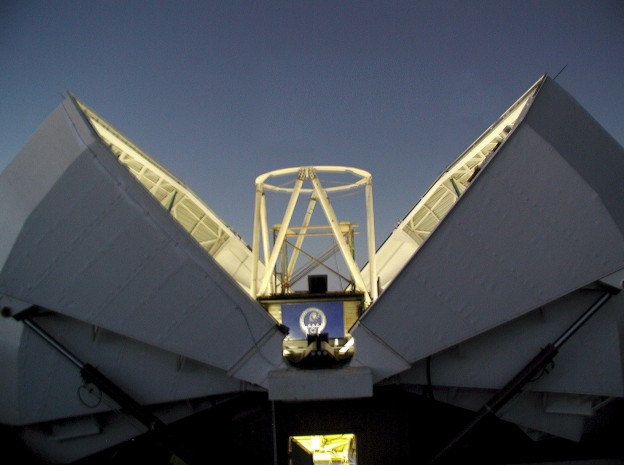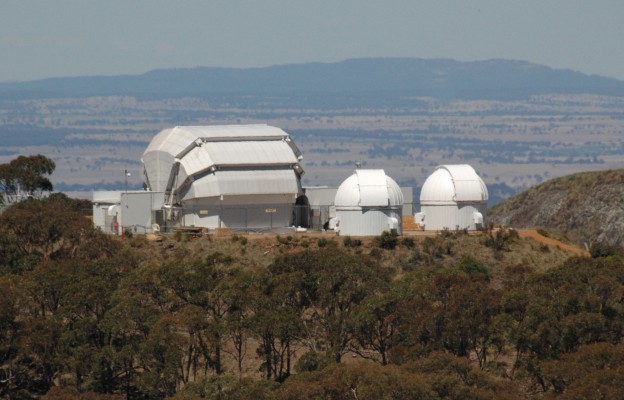by Edward Gomez
- Published: Wednesday, April 16 2014 12:46
The atmosphere is rather handy for us as humans because it allows us to breathe, keeps us warm (warmer than space at any rate) and shields us from harmful radiation from the Sun, cosmic rays, small meteors and other things that go bump in the night. So I don’t want to sound ungrateful but it’s a pain in the rear for us astronomers.

Faulkes Telescope North Opening. Credit: LCOGT
Astronomy is virtually unique amongst the sciences because the only way we can unravel the mysteries of the Universe is by deciphering information locked away in light rays. To be an astronomer you have to be resourceful and extract every gram or millimetre of science from every ray of light.
We put our telescopes in strange exotic locations, like up mountains in Chile or at the summit of dormant volcanoes in Hawaii. Because the air is thinner higher up, this minimises stars' twinkling and makes our view of the night sky really sharp. If you choose your location carefully you can also eliminate the glare from street lights, which reflect off the atmosphere giving the sky an artificial brightness. Air quality is important because any particles in the air will reflect light and make the sky glow. And finally weather. Ideally you would like to put your observatory above the clouds or at least some of them.
Taking all of that into consideration you have put your observatory in a remote place, away from cities and built up areas, 10-15,000 feet above sea level.
If you only have one telescope you are at the mercy of the elements, unless you can put it in the back of a van move it to and move it to a different Hawaiian island or remote mountain. For all practical purposes this is impossible.
Fortunately we can avoid all of that hassle by making our telescope robotic. With carefully designed systems for monitoring weather, sky conditions, instrument statuses, telescope telemetry, a small amount of computer code and the internet, you can have yourself a robotic observatory. Many amateur astronomers have robotic observatories in their back gardens. But these are mostly dumb robots, that require a person at the other end who is remote controlling every aspect – like when to open the observatory dome, and what to observe.
The really challenging part is then to remove the person and making the observatory totally autonomous. This requires much more computer software, which can make decisions about whether the sky conditions are good and what to observe from a queue of requests. You also have to build in contingencies for something going wrong. If your telescope gets in a pickle, some part of the autonomous control system has to recognize the signs, make the observatory safe, and alert a person so that it can be repaired.
It is an involved process to make an observatory autonomous but it can make the difference between an average observatory and world class one. If part of your software is an adaptive scheduler you can take all your observation requests and turn them into an efficiently packed together schedule with minimum amount of gaps. You can increase your on-sky time, allowing you to get more observations of more astronomical objects for more people.

Faulkes Telescope North. Credit : LCOGT
There is still the problem if you only having one telescope. What happens when the weather rolls in or worse still something happens to break your telescope? The answer is simple: build more telescopes and build them in different locations. Splitting your telescopes between the northern and southern hemispheres and spreading them out evenly across the globe allows you to have full sky coverage. By doing this you not only have a wet weather and technical difficulty contingency but you have something potentially more valuable. If you add in the internet and some more software, you have a telescope network, which is more powerful than the sum of its parts. Your intelligent autonomous scheduler has a much bigger resource to play with now, virtually guaranteeing that there will be somewhere on the globe suited to observe exciting astronomical phenomena.

Siding Spring Observatory. Credit: LCOGT
This sort of approach is being pioneered by Las Cumbres Observatory Global Telescope Network. It is a daunting task to build all of this from the ground up with all the software and most of the engineering done in-house. This is the first example of an autonomous network of telescopes on this scale and is geared towards discovering and following-up transient phenomena which need to be rapidly observed or they are lost forever.
Some of the most exciting results we have seen are because we have robotic telescopes which can rapidly respond to the first sighting of a new astronomical event. We have been involved in the discovery and classification of extrasolar planets by looking at a tiny dip in the brightness of a star which indicates a planet passing in front of us and the host star; follow-up observations of newly discovered exploding stars, called supernovae, to not only understand why they exploded but also learn about mysterious Dark Energy.
With robotic telescopes anyone can make exciting scientific discoveries from the comfort of their homes or even in the pub. We used to call these people ‘armchair astronomers’ but now they are part of a larger group of Citizen Scientists.
###
 Edward Gomez is a professional astronomer, working for Las Cumbres Observatory. Education and public outreach is extremely important to him and he is always looking for interesting and innovative ways to engage the public in astronomy. He is chair of the IAU's task force for children and schools as part of the Office of Astronomy for Development and managing editor of astroEDU, a peer-review platform for astronomy education activities.
Edward Gomez is a professional astronomer, working for Las Cumbres Observatory. Education and public outreach is extremely important to him and he is always looking for interesting and innovative ways to engage the public in astronomy. He is chair of the IAU's task force for children and schools as part of the Office of Astronomy for Development and managing editor of astroEDU, a peer-review platform for astronomy education activities.








Comments